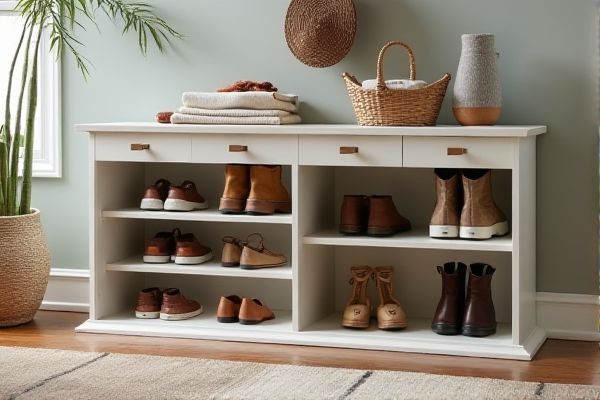
A vented shoe cubby allows for better air circulation, reducing odor and moisture buildup, whereas a solid shoe cubby provides more protection from dust and debris while maintaining a sleek appearance. Discover which option best suits Your storage needs by reading the rest of the article.
Table of Comparison
| Feature | Vented Shoe Cubby | Solid Shoe Cubby |
|---|---|---|
| Airflow | High, allows shoes to dry and prevents odor buildup | Low, limited ventilation can trap moisture and odor |
| Protection | Moderate, exposes shoes to dust and dirt | High, offers full protection from dust and external damage |
| Durability | Varies, depends on vent design and material | Generally higher, solid panels add strength |
| Appearance | Casual and breathable look | Clean, sleek, and modern appearance |
| Best Use | Warm, humid environments; athletic or frequently worn shoes | Storage-focused; long-term shoe protection in dry environments |
Introduction to Shoe Cubby Designs
Shoe cubby designs typically come in two main types: vented and solid. Vented shoe cubbies feature perforations or slats to promote air circulation, reducing moisture buildup and odor in your footwear storage. Solid shoe cubbies offer a more enclosed space, providing protection from dust and maintaining a tidy appearance while limiting airflow.
What is a Vented Shoe Cubby?
A vented shoe cubby features slotted or perforated panels that improve air circulation, helping to reduce moisture and odor buildup in stored shoes. This design is ideal for keeping your footwear dry and fresh, especially after workouts or rainy days. In contrast, a solid shoe cubby has enclosed sides that protect shoes from dust but may trap humidity, affecting shoe condition over time.
What is a Solid Shoe Cubby?
A solid shoe cubby features fully enclosed compartments that protect your shoes from dust, dirt, and moisture, making it ideal for maintaining shoe condition over time. Unlike vented shoe cubbies, which allow airflow to reduce odor and moisture buildup, solid cubbies prioritize security and a clean appearance by providing complete coverage. Your choice depends on whether you value protection and aesthetics or breathability and ventilation for stored footwear.
Airflow and Ventilation Benefits
A vented shoe cubby provides superior airflow, reducing moisture buildup and preventing odors by allowing shoes to dry more efficiently. Solid shoe cubbies, while offering a cleaner look, can trap humidity and increase the risk of mold or mildew growth inside. Choosing a vented design supports better ventilation and keeps Your footwear fresher for longer.
Moisture and Odor Control Comparison
Vented shoe cubbies excel in moisture and odor control by allowing air to circulate freely, preventing the buildup of dampness and reducing the risk of mold and mildew. Solid shoe cubbies, while offering more protection from dust and visible clutter, tend to trap moisture, creating an environment conducive to unpleasant odors and accelerated shoe degradation. Your choice between vented and solid cubbies impacts how effectively your footwear remains dry and fresh over time.
Durability and Maintenance
Vented shoe cubbies offer enhanced airflow, reducing moisture buildup and preventing odor, which helps maintain your shoes' freshness and extends the cubby's lifespan. Solid shoe cubbies, made from sturdy materials like wood or metal, typically provide superior durability against heavy wear but may require more frequent cleaning due to lack of ventilation. Your choice hinges on balancing long-term durability with ease of maintenance tailored to your storage environment.
Aesthetic and Design Options
Vented shoe cubbies offer a modern, airy aesthetic with slatted or perforated designs that allow visibility and airflow, enhancing breathability and reducing odors. Solid shoe cubbies provide a sleek, seamless appearance with clean lines and a uniform surface, ideal for minimalist or contemporary interiors seeking to conceal footwear completely. Both options feature versatile material choices like wood, metal, or plastic, but vented designs emphasize functional ventilation while solid cubbies prioritize aesthetic cohesion and discreet storage.
Space Efficiency and Storage Capacity
Vented shoe cubbies offer enhanced airflow but generally have less storage capacity due to gaps and holes, making them less space-efficient for maximizing your shoe collection. Solid shoe cubbies optimize space efficiency by providing maximum storage capacity with enclosed compartments that can stack or fit more shoes in a confined area. Choosing between the two depends on prioritizing ventilation versus maximizing storage in your organization system.
Best Uses and Suitability
Vented shoe cubbies are ideal for environments requiring improved air circulation, such as gyms or homes in humid climates, as they help reduce moisture buildup and odors. Solid shoe cubbies offer better protection against dust and dirt, making them suitable for entryways or closets where keeping shoes clean is a priority. Choosing between vented and solid designs depends on whether ventilation or protection aligns better with the storage needs.
Choosing the Right Shoe Cubby for Your Needs
A vented shoe cubby promotes air circulation, reducing odor and moisture, making it ideal for damp or high-use environments. A solid shoe cubby offers more protection from dust and a cleaner appearance, suitable for organized spaces or delicate footwear. Consider your storage space, shoe type, and ventilation needs to ensure your shoe cubby matches your lifestyle and keeps your shoes in optimal condition.
 homyna.com
homyna.com